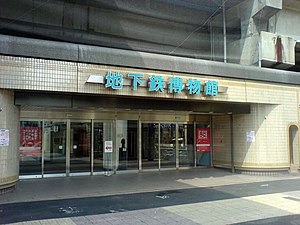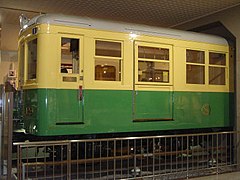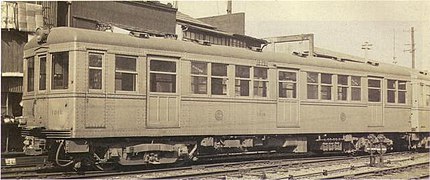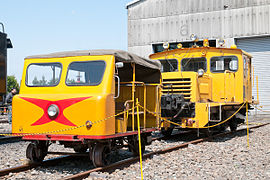Tokyo Subway Museum

|
|
| Data | |
|---|---|
| place | 6-3-1, Higashi-kasai, Edogawa-ku , Tokyo , 134-0084, Japan |
| Art |
Transport Museum
|
| opening | 1986 |
| operator |
Metro Cultural Foundation
|
| Website | |
The Underground Museum Tokyo ( Japanese 地下鉄博物館 Chikatetsu Hakubutsukan , English Tokyo Metro Museum , in short Chikahaku ) is a 1986 opened at ground level and lying Transport Museum Station Kasai of the Tozai Line in the district Edogawa in Tokyo . It is operated by the non-profit Metro Cultural Foundation ( 公益 財 団 法人 メ ト ロ 文化 財 団 Kōekizaidan hōjin metoro bunkazaidan ), which belongs to the Tōkyō Metro .
history
As part of its non-profit activity, the Metro Support Association ( 地下 鉄 互助 会 Chikatetsu Gojokai ) began to draft plans for the construction of a subway museum in 1983 . The construction project, which cost around 22 million euros, started in February 1985. The museum opened its doors to visitors a year later on July 12, 1986. Shortly before the opening, the "Transportation Museum" ( 交通 博物館 Kōtsū hakubutsukan ), which had its seat in the Kanda-Sudachō district in the Chiyoda district , had an exhibition . The Transportation Museum, which had existed since 1934, was closed in 2006. The Saitama Railway Museum was established as its successor in 2007 .
After the devastating Kobe earthquake in 1995 ("Hanshin Awaji earthquake catastrophe"), all high bridges across the country were checked for their earthquake safety and were overhauled by construction measures. Improvement measures also had to be carried out on the Tōzai Line, which is why the museum was closed for almost a year, from July 2002 to May 2003. This break was used to reorganize the entire exhibition.
Themed rooms
The museum has a total of seven rooms with different subject areas on an exhibition area of 3535 m², in which 600 exhibits are presented. The focus of the themed rooms are:
- History of the subway
- Construction of a subway
- Security around the subway
- Passenger care
- How trains work
- Japanese and international subways
- Play Land subway
The museum also has an auditorium for lectures, a museum shop, an area for special exhibitions, a library and a simulator (Metro Panorama), a model railway that is demonstrated four times a day by trained drivers with explanations.
Exhibits
The 600 exhibits include a number of historic trains. The cars on display include the first car from the 300 series of the Marunouchi line . You can also see a historical train No. 129 of the Tokyo S-Bahn from the class 100 ( 東京 高速 鉄 道 100 形 電車 ). There is also a historic Tokyo subway car from the 1000 series, which was declared an important cultural asset in 2017 . The train dates back to 1927 and ran the first subway line opened in Japan between Ueno Station and Asakusa Station . A Tokyo Metro series 01 car ( 営 団 01 系 電車 ) can also be seen. There are also motor vehicles that are used to inspect tunnels.
In addition to the trains, replicas of subway facilities are also shown. This includes a replica of the historic platform of Ueno Station on the Ginza Line as it was in 1927, when the station opened as the first section of the metro. In addition, the automatic ticket inspection system common in Japan ( 自動 改 札 機 Jidō kaisatsuki ) at the subway entrances. They consist of the ticket machines and a small gate where the tickets are automatically checked and stamped.
gallery
Web links
- Tokyo Metro Museum. Retrieved November 8, 2019 (English, Museum Official Website).
Individual evidence
- ^ Exhibits. Retrieved on November 8, 2019 (English, with a map of the rooms).
- ↑ 施 設 の ご 案 内 . Retrieved November 8, 2019 (Japanese).
Coordinates: 35 ° 39 '48.6 " N , 139 ° 52' 25.9" E






